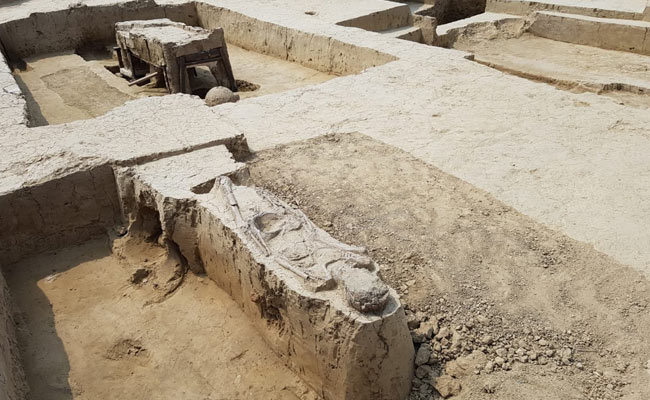Two wooden “legged coffins” with skeletons and several other artifacts of the late Harappan period were discovered by the Archaeological Survey of India (ASI) at an excavation site in Uttar Pradesh, the Ministry of Culture said Tuesday.
The artifacts excavated at the site in Sanauli, located on the left bank of the Yamuna river and 68-km northeast of Delhi, are contemporary to the late phase of a mature Harappan period between 2100 BC and 1900 BC.
The excavation is still in progress.
Fresh excavations at Sanauli were carried out till January on two sites– one which was inhabited and the other where people buried their dead, the ministry said in a statement.
These artifacts belong to the Copper Hoard culture and the Ochre Coloured Pottery (OCP) culture.
In the first area, two burial pits and a sacred chamber built of burnt bricks were discovered along with burial goods.
The statement said, in one of the burial pits, a wooden “legged coffin” decorated with steatite inlays and having a skeleton of a female was found.
This burial pit contained evidence of decomposed bone points, a bow, an armlet made of semiprecious stones, gold beads and pottery, including vases, jars and bowls. These were systematically arranged towards the north and eastern sides of the coffin, it said.
The statement said an interesting find from this burial pit is an antenna sword, which was placed near the head of the skeleton.
“The pelvis of the skeleton is sinking in the middle, indicating the process of decomposition of the wooden base of the coffin (in burial pit No 9), a similar feature which was also seen in the other burial pit (No 10).
“Burial pit No 10 includes an extended female skeleton in disturbed condition. The burial goods include a copper mirror, a hairpin, a channel, beads and pottery,” it said.
Two big pots are placed under the coffin. These could have contained food and other organic remains associated with rituals of those times.
To the north of the two pits is the sacred chamber.
“This could have been used for making preparations for the soul before the burial was made,” the ministry’s statement said.
“The nature of burial pottery, coffins, antiquities such as the antenna sword, pottery, etc. suggest a complex of late Harappan period.
“Sanauli therefore is important in not only giving new evidence of copper decorated chariots, coffins, shields, helmets in the Indian sub-continent first time with antenna swords, dagger, etc but also in understanding of the cultural scenario of upper Ganga-Yamuna doab,” it said.





